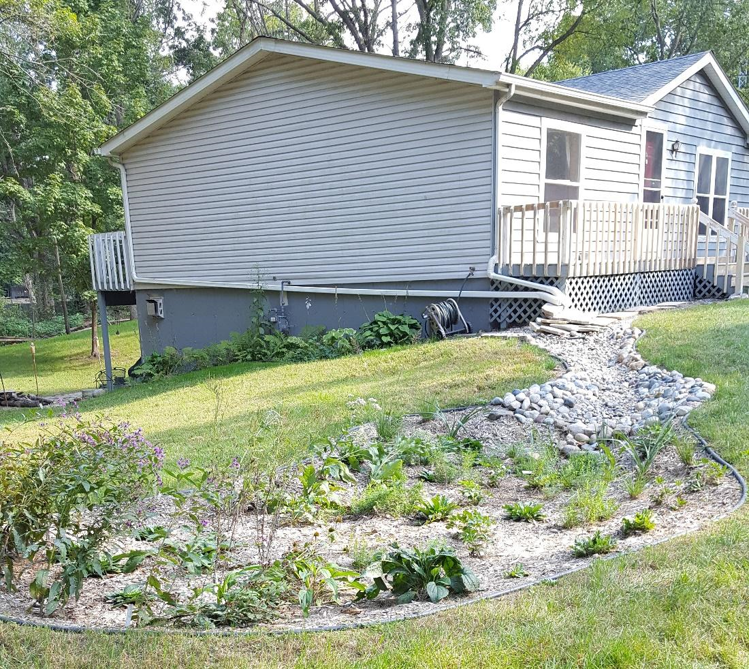What is a rain garden?
A rain garden is a shallow depression (typically 6-8 inches deep) in your yard that is planted with native wildflowers and grasses. This popular type of perennial garden is strategically located to capture runoff from impervious surfaces such as roofs, driveways, and patios. The garden holds water allowing it to infiltrate into the ground within 24-48 hours.

Why install a rain garden?
Rain gardens are not only beautiful, but they absorb water and pollutants, reduce runoff, protect water quality, and prevent flooding. A rain garden on your property helps prevent stormwater pollution. Rain gardens absorb hundreds of gallons of rain that would otherwise wash pollutants from your lawn and roof down the street into the nearest river, stream or lake. Even small rain gardens can absorb a lot of rainwater!
Where to build a rain garden?
Most home rain gardens are simply a depression in the ground, with no fancy pipes or special soil. If a depressional area is not already present, determine where the water from downspouts, driveways or other impervious surfaces flows and plan to install your rain garden where it will capture the most rainwater runoff. To help decide where to put a rain garden, consider these points:
- Before beginning any project, check homeowner association covenants, as well as local and county ordinances. Do not work in a drainage, utility, or other easement without the proper permits. Contact Indiana’s Call Before You Dig center (811 or 1-800-382-5544) to identify any buried utilities.
- The rain garden should be at least 10 feet from a structure with a basement and 4 feet from a slab foundation or sidewalk so infiltrating water does not damage infrastructure.
- Do not place the rain garden directly over a septic tank or leach field.
- We highly recommend performing a percolation test on your proposed site before finalizing your choice to ensure your garden will drain in 24-48 hours. Work with your local SWCD office on how to conduct a percolation test or watch the informative rain garden planning and installation videos from Purdue Extension here.
- Installing a garden in full sun will allow it to dry more quickly and will give you more plant options but planting in the shade is absolutely possible. When digging and planting near large trees you will also have to watch out for and avoid tree roots.
- Putting the rain garden in a flatter part of the yard will make digging much easier. The steeper the slope, the deeper the garden must be to be level.
- Catching Rain Fort Wayne has a website dedicated to all things rain garden. Check out their resources here.

Choose Native Plants
Native plants are species that were growing in Indiana long before we settled here. These plants are tolerant of Indiana’s climate, benefit our native wildlife, and require less maintenance than their exotic counterparts.
There are dozens of native choices for rain gardens – the species you choose should be based on your site conditions for light, moisture, and soils. Use your personal preference for plant structure, height, flower characteristics, and attracted wildlife.
Once the garden is dug, plants can be installed from May to mid-August. However, summer plantings may need frequent watering. Seedlings should be planted 12 to 18 inches apart with flood tolerant species toward the bottom and drought tolerant species towards the edge.
Make sure your plantings receive at least one inch of water a week for the first two months or until they show that they are growing and well established. Once the plants are established, they’ll thrive without additional watering. Fertilizers are not necessary, and weeding will not be needed once the initial weeds that appear have been removed.
*Nurseries may offer native rain garden plant “packages” to help make plant selection a breeze!
Possible Challenges
Urban soils are often extensively altered and heavily compacted during development. This is one reason your soil could fail the percolation test mentioned earlier. Compacted soils may need to be excavated and replaced with a mixture of 50% sand, 30% compost, and 20% soil. You may also need to install a tile drain under the garden; the tile will lower the water table and allow water to percolate through an amended soil profile. There are several other ways to remedy poorly draining soils; consult your local SWCD for more information.
Benefits of a Rain Garden
- Increase the amount of water that filters into the ground, which recharges local and regional aquifers
- Help protect communities from flooding and drainage problems
- Help protect streams, rivers, and lakes from pollutants carried by urban stormwater (lawn fertilizers and pesticides, oil and other automotive chemicals, and numerous harmful substances that wash off roofs and paved areas)
- Enhance the beauty of yards and neighborhoods
- Provide valuable habitat for birds, butterflies, and many beneficial insects